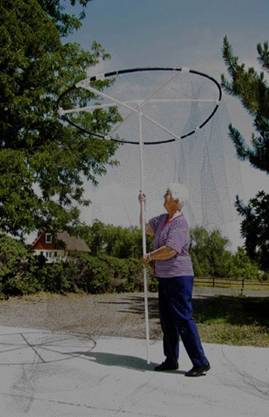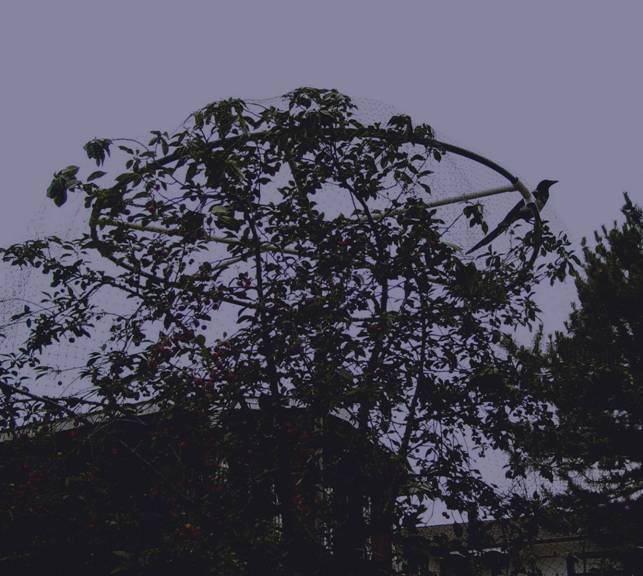56.FruitGoingToTheBirdsandSquirrels.doc
- Subject: [GWL] 56.FruitGoingToTheBirdsandSquirrels.doc
- From: "* H* <r*@netbrellakit.com>
- Date: Fri, 7 May 2004 12:08:34 -0600
- List-archive: <http://lists.ibiblio.org/mailman/private/gardenwriters>
Title:
|
Is Your Fruit Going to the Birds and Squirrels? Ray Hauser, Inventor
Netbrella in transit from cherry tree to peach tree, summer 2003 In the 30 years that I’ve lived out in the county and have tried to grow my own cherries, peaches, and plums, I’ve fought the bird problem every year. Without netting, my cherries don’t reach a ripe condition – they’re gone about the time they turn from green to yellow. My peaches and nectarines have been bird-pecked, and many of my plums have been pecked off the tree onto the ground, again prior to ripening. I haven’t been bothered by squirrels, but my daughter and a neighbor have had their apple and peach crops destroyed when their fruit was nut-sized. One bite from the furry-tailed rodent dropped the fruit from the tree, but a bite from one was never enough, and the ground became littered with trash. I bought bird netting and then fought the problem of placing and removing the nets every season. Lacking a team of NBA players, my dad, son and I attempted to place nets with a number of poles. We once placed a large net onto a Montmorency cherry by rolling the two halves of the net toward the center and lifting the double-roll skyward onto the top of the tree. We then unrolled each half over the branches. That year, I left the net on the tree rather than remove it; small branches perforating the netting always made this a chore. That year, a heavy snowfall removed the net (in pieces) along with a couple of branches from the tree. At the suggestion of my older sister,
I became a convert to dwarf fruit trees so that nets could be placed more
easily. I soon found that the weight of
the net tries to reform the outer branches to the form of a weeping
willow. And I found that even a 7-foot
tree is a challenge to placement of a net by one individual. (Dad is now gardening in heaven; my son took
his music to I applied for a patent on the net-supporting kit, but the following instructions can be used for making your personal netting support. For a tree that is up to 7-foot diameter and height, the assembly is a wheel made of ¾” polyethylene pipe with a slip coupling which forms the rim, 6 PVC ¾” pipe tees which slip over the rim, an equal number of spokes and three central PVC tees to accept the spokes. The central PVC fittings are specially drilled to accept a ¾” PVC pipe which forms the central pole for this wheel, going completely through the vertical stem of two tees and part way through the top tee. For 10-foot trees, 8 tees fit onto the rim, and two central PVC pipe crosses anchor the inward end of the spokes. Both crosses are drilled perpendicular to its four sockets, one a through-hole, the other to the top wall. A netting support of this larger size needs the stiffness of a 1-inch PVC central pole, so a transition is made at the top from ¾” PVC pipe to 1” PVC pipe with a reducing coupling. Once assembled, the wheel is placed over the central third of a folded tree netting (preferably the 28x28-foot size) and its rim is attached to the center of the net with wire ties. This is best done by first folding the netting into thirds, starting from one edge and making two folds in a single direction, leaving the central third on top. The wheel is then placed over the center of the net and this layer of the net is attached to the wheel with wire ties. Thereupon, the pole can be lifted in umbrella fashion and the net can be carried to the fruit tree. The pole is then tied to the trunk of the tree in at least two locations to keep it upright, and the net is folded down from its top position. The bottom of the netting can be pulled together around the trunk, or it can be weighted or staked to the ground to prevent birds from a basement entry and entrapment. For removal from the cherry tree after the glorious harvest, two sides of the net are lifted up onto the top of the wheel, and the assembly can be carried to the apricot, peach, nectarine or plum tree for further benefit in the same season. This can usually precede invasion by the local squirrels. At the end of the harvest, the support can be disassembled if storage room for the “big wheel” is limited. I simply roll up the netting onto a bundle of spokes. For folks handy with a saw, but lacking the tools to drill holes through PVC fittings about 1.1” diameter, Netbrella® kits of the custom parts are available. You cut polyethylene and PVC pipe sections to fit the fruit tree and assemble with pre-drilled parts from the kit. Netbrella™ models 7 and 10 fit trees that are about 7 and 10 feet in diameter and height. The kits can be purchased at www.netbrellakit.com for $10 and $15, respectively. Even though I have applied for a patent on the Netbrella® kit, I don’t object to folks making their own. Ray Hauser, Inventor 5758 Rustic Tel 303-530-3950
Non-Thieving Magpie on a Netbrella |
|
|
_______________________________________________ gardenwriters mailing list gardenwriters@lists.ibiblio.org http://lists.ibiblio.org/mailman/listinfo/gardenwriters GWL has searchable archives at: http://www.hort.net/lists/gardenwriters Send photos for GWL to gwlphotos@hort.net to be posted at: http://www.hort.net/lists/gwlphotos Post gardening questions/threads to "Gardenwriters on Gardening" <gwl-g@lists.ibiblio.org> For GWL website and Wiki, go to http://www.ibiblio.org/gardenwriters
- Prev by Date: Re: Q&T news
- Next by Date: Re: Q&T news
- Previous by thread: Re: gardenwriters Digest, Vol 16, Issue 12
- Next by thread: Re: Q&T news



